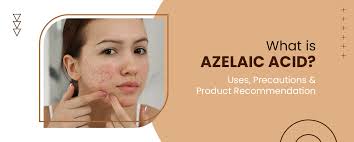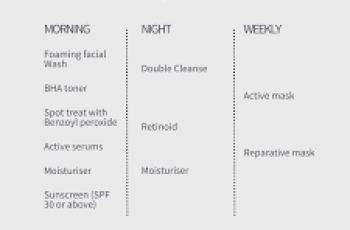What is Azelaic Acid? And what are its benefits for skin care?
I know some of you may grumble at the thought of having to learn about yet another facial acid. But this particular acid is truly special. If your skin is prone to rashes or other issues like rosacea, then azelaic acid is the acid for you.
What is Azelaic Acid?
Extracted from grains like barley, wheat, and rye, azelaic acid is used in skin care as an effective chemical peel with antioxidant properties that can soothe the skin and reduce any factors that cause inflammation, rashes, irritation, or redness.
It is a lesser-known acid that is currently undergoing medical research into its effects on the skin, which also means you’ll be hard-pressed to find it in many skin care products, but in some ways, that makes it more interesting and a holy grail for some.
Prescription products contain high levels of Azelaic Acid, where you can find up to 20% concentrate in these formulas, while over-the-counter products have significantly lower levels but are still considered very effective and are a great starting point for anyone looking to add AHAs into their daily skin care routine. As always, we recommend that you consult a dermatologist before using Azelaic Acid.
What Does Azelaic Acid Do for Skin?
As mentioned before, azelaic acid is less well known and can be difficult to find in over-the-counter products. It’s also notoriously difficult to incorporate into skincare serums and moisturizers. For brands that have found a winning blend, you’ll find that after using azelaic acid-rich products, you’ll experience a range of effects and reduce signs of common skin concerns, such as:
Common Blemishes & Imperfections
Pigmentation Spots & Uneven Skin Tone
Scars & Uneven Skin Texture
Dull Skin
Increased Sensitivity & Redness
Azelaic acid can benefit the skin by maintaining the function of skin cells and keeping the top layer of the skin at its healthiest and smoothest appearance. Although azelaic acid is sometimes mistakenly considered a member of the broader AHA and BHA family, it’s actually a standalone skincare ingredient that isn’t as effective as other well-known acids like salicylic or lactic acid. That doesn’t mean it’s not as effective, and can easily be incorporated into a routine that already has AHAs and BHAs to bring an extra layer of skin-healing benefits to your routine. By using a blend of these skincare ingredients, you can combat blemishes and uneven skin tone and minimize signs of aging.
For more information on alpha hydroxy acids and beta hydroxy acids, check out our comprehensive guide to AHAs and BHAs to better understand which acid is best for your skin type and concerns.
Can Azelaic Acid be Used Every Day?
Yes, you can! Azelaic acid has been studied in most medical studies for prescription products. This suggests that the ingredient is stable enough to be used every day, morning and night. Keep in mind that azelaic acid can be very drying to the skin and, in some cases, can cause it to peel. To prevent this from happening, introduce the acid into your routine slowly at first, using it only at night and following with a hydrating and nourishing oil or moisturizer. Once your skin has developed the necessary tolerance, you can use it daily. However, always make sure to use an SPF of 30 or higher every day to protect your skin from harmful UV rays and sun damage.
When Should You Use Azelaic Acid in Your Routine?
For active ingredients like azelaic acid, it is most beneficial to use products that stay on the skin longer. Face washes and cleansers are a very important part of any skin care routine, but they work less on the skin because they are rinsed off the skin. If you opt for a serum and moisturizer, the acid can remove dead skin cells and fade dark spots and signs of aging. After using a serum or moisturizer rich in azelaic acid, I recommend using a hydrating gel-like formula with a high concentration of hyaluronic acid to prevent dryness and restore skin balance.
What are the side effects of using azelaic acid?
The most common side effects when using azelaic acid are:
Burns
Skin stinging
Peeling of the skin in certain areas after use
Dryness
Redness
To combat these issues, you can follow some simple steps such as: For example, apply moisturizer and make sure to always use sunscreen during the day, even on cloudy days. Less common side effects may also occur if you find yourself suffering from any of the following: Stop using azelaic acid and consult your doctor for further advice.
Less Common Reactions
Blistering of the Skin
Irritation
Swelling
Hives and Itching
Difficulty Breathing
Tense and Joint Pain
Fever
When you first introduce azelaic acid into your routine, it is highly recommended that you perform a 24-hour patch test. If signs of a skin reaction occur, do not use the product on your skin and seek help from your doctor.
Well, at least now you can cross azelaic acid off your list of “effective skin ingredients I need to know about.” While it’s still shrouded in mystery because it’s not as well-researched as other facial acids, it’s gaining popularity among skincare gurus and other experts. With her ability to treat stubborn skin issues like blemishes and rosacea, who knows how many skin-rejuvenating secrets she has!
DQH Can I use salicylic acid first and then vitamin C?
It’s easy to create a skincare routine, but knowing how to use it is another thing entirely. In most cases, if you’re not getting the desired skin results, it could be due to the layering of conflicting ingredients. So, is it possible that salicylic acid and vitamin C are such ingredients? Or are these active ingredients the duo that’s been missing from your skincare routine? If you want answers, stick around because today we are going to explain the benefits of salicylic acid and vitamin C and how they can be used in your daily life.
What are the benefits of salicylic acid for skin?
Salicylic acid is one of the most commonly used beta hydroxy acids and is favored by many people with oily, acne-prone skin. This acid is derived from willow bark, and unlike its water-soluble relatives (called alpha-hydroxy acids), salicylic acid is oil-soluble, which means it can penetrate deeper into the lower layers of the skin. Once it reaches the lower layers, it can help unclog pores of excess sebum, dirt, bacteria, debris, and impurities. This results in clearer skin tones and greater definition.
Not only does salicylic acid benefit the underlying layers, but the outer surface of the skin benefits as well. When applied to the skin, salicylic acid removes the buildup of dead skin cells. This is accomplished by breaking the bonds that hold dead cells to the surface. Over time, this can cause the complexion to look dull and prone to acne, blackheads, and other blemishes.
If you’d like to learn more about salicylic acid and how it can improve your skin, check out this dedicated blog post from a beauty insider.
What are the benefits of vitamin C for skin?
Vitamin C is considered one of the most powerful antioxidants, which means it is very effective at fighting free radicals and preventing them from causing further skin damage. Examples of free radicals include pollution, central heating, UV rays and harsh climate. They attack proteins, fats and cell membranes as soon as they come into contact with the skin, causing signs of premature aging such as fine lines and wrinkles as well as hyperpigmentation, flaky patches of skin and loss of elasticity.
Many people usually prefer to use vitamin C in their morning routine as this ingredient gives the complexion a radiant glow. You’ll also find that vitamin C can target areas of hyperpigmentation, plumping the skin and reducing the appearance of fine lines and wrinkles.
The thing about vitamin C is that there are a lot of outdated studies going back to the 1950s that describe vitamin C as an unstable skin component. Thanks to improvements in modern technology, this is no longer the case as all products now contain a stable form of vitamin C.
Visit The Beauty Insider to learn more about vitamin C. So please check out our blog post.
Can I use salicylic acid first and then vitamin C?
Yes, you absolutely can. In fact, it’s thought that using salicylic acid before using vitamin C ensures it penetrates faster and works faster.
This is an efficient way to utilize two power sources, and the reason has to do with pH. For example, the skin’s natural pH is about 4.7, making it slightly acidic. Salicylic acid and vitamin C are also both acidic, and you’ll find that vitamin C is absorbed quickly into the skin. Therefore, using salicylic acid beforehand can increase the acidity of the skin and allow vitamin C to penetrate into the skin faster.
While this is considered an effective way to combine two powerful ingredients, you need to be aware of your skin type and how it reacts to certain active ingredients. Even people with perfect, normal skin can experience skin sensitivity and irritation. Therefore, always consult a doctor or dermatologist before using any new products on your skin.
It’s also important to follow skin application rules. In this case, you need to use the product correctly to ensure you get the best results for your skin. If you’re not sure what I mean, the basic rule for skin is to start with the thinnest consistency and work your way up to the thickest consistency. This prevents a barrier from forming on the surface, preventing other active ingredients from penetrating the skin.
Can I use salicylic acid at night and vitamin C in the morning?
Yes, absolutely, this is considered the most effective way to get returns without any adverse side effects. This is because there is enough time between applications to ensure that the skin’s pH levels return to balance.
You’ll also find that Vitamin C is rich in antioxidants and is perfect for use in the morning to ensure your skin is protected and looking its healthiest. Due to the small size of salicylic acid molecules, it is an acid that is able to reach the deepest parts of the skin. While this is effective at keeping skin clear, it also increases the risk of irritation and photosensitivity. Therefore, many people prefer to use powerful BHAs in their evening routine without exposure to UV rays, pollution, or harsh weather.
Warning: If you avoid using sunscreen every day, none of these ingredients will do what your skin needs. The combination of chemical peels and powerful ingredients increases the risk of further damage to the skin’s surface. Use SPF 50 every day to keep your skin protected and your lipid barrier healthy, even on cloudy days, keeping your skin in top condition.



